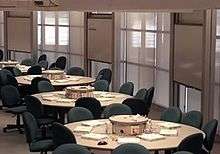SCALE-UP
SCALE-UP is a learning environment specifically created to facilitate active, collaborative learning in a studio-like setting. Some people think the rooms look more like restaurants than classrooms.[1] The spaces are carefully designed to facilitate interactions between teams of students who work on short, interesting tasks. A decade of research[2][3] indicates significant improvements in learning. The approach taken during the development and testing of the learning environment is an application of scientific teaching and has been discussed in several books.[4][5][6][7] Although originated at North Carolina State University, more than two hundred colleges across the US and around the world have directly adopted the SCALE-UP model and adapted it to their particular needs.

The SCALE-UP name originally stood for “Student-Centered Activities for Large Enrollment Undergraduate Physics” but since its conception many different institutions have begun teaching a variety of courses of various sizes. The acronym was changed to “Student-Centered Active Learning Environment for Undergraduate Programs.” Now, because of the increasing number of pre-college installations, plus to draw attention to the instruction as well as the space, the name has become "Student-Centered Active Learning Environment with Upside-down Pedagogies." The basic idea is that students are given something interesting to investigate. While they work in teams on these "tangibles" (hands-on measurements or observations) and "ponderables" (interesting, complex problems), the instructor is free to roam around the classroom–--asking questions, sending one team to help another, or asking why someone else got a different answer. There is no separate lab class and most of the "lectures" are actually class-wide discussions. The groups are carefully structured and give students many opportunities to interact. Three teams (labelled a, b, and c) sit at each round table and have white boards nearby. Each team has a laptop in case they need web access. The original design called for 11 tables of nine students, but many schools have smaller classes while a few have even larger ones.
-

NCSU Pilot Room before modifications, seating 55 students
-

NCSU Pilot room after modifications, seating 54 students]
-

MIT The d'Arbeloff Studio Classroom, seating 117 students
References
- ↑ J. Gaffney, E. Richards, M.B. Kustusch, L. Ding, and R. Beichner, "Scaling up education reform,"Journal of College Science Teaching, 37 (5), 2008.
- ↑ Beichner, R., Saul, J., Abbott, D., Morse, J., Deardorff, D., Allain, R., Bonham, S., Dancy, M., and Risley, J. (2006). “Student-Centered Activities for Large Enrollment Undergraduate Programs (SCALE-UP) project.” In E. F. Redish and P. J. Cooney (Eds.), PER-Based Reform in University Physics. College Park, MD: American Association of Physics Teachers.
- ↑ Y. Dori and J. Belcher, How does technology-enabled active learning affect undergraduate students' understanding of electromagnetism concepts, Journal of the Learning Sciences, 14(2), 2004.
- ↑ Beichner, R., Dori, Y., and Belcher, J. (2006). “ New Physics Teaching and Assessment: Laboratory and Technology-Enhanced Active Learning..” In Mintzes, J. and Leonard, W. (Eds.), Handbook of College Science Teaching, Washington DC: National Science Teachers Association.
- ↑ R. Beichner, “North Carolina State University: SCALE-UP.” In Oblinger, D. (Ed.), Learning Spaces, Boulder, CO: Educause, 2006.
- ↑ R. Beichner, and J. Saul, Introduction to the SCALE-UP (Student-Centered Activities for Large Enrollment Undergraduate Programs) Project. In Invention and Impact: Building Excellence in Undergraduate Science, Technology, Engineering and Mathematics (STEM) Education, proceedings of a conference by the American Association for the Advancement of Science, April 2004, Washington DC, 2005.
- ↑ M. Oliver-Hoyo and R Beichner, "The SCALE-UP Project," in Teaching and Learning through Inquiry: A Guidebook for Institutions and Instructors, edited by V. S. Lee (Stylus Publishing, Sterling, VA, 2004).